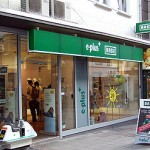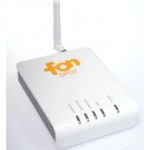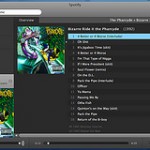When we started FON, our idea was to develop a piece of software that turns your router into a member a global family of routers who share wifi. So first we released an open source download that would convert certain router models into FON routers but we failed with the download model. Even though FON appeared in most blogs, the New York Times and many newspapers and magazines around the world, we discovered that there were not enough people interested in a download. We diagnosed this lack of interest for three reasons: first, people saw little value in being early adopters, second, they feared that sharing would leave them without bandwidth; and third, they were afraid that strangers would get into their WiFi networks (now many people have WiFi printers, WiFi media servers, etc).
So in April 2006, we changed our strategy and decided to work on developing a piece of hardware that addressed all these concerns: the La Fonera. For this effort we had to hire many engineers, and it was a very difficult task to accomplish. But in only 5 months we designed, built and launched the La Fonera. And that´s when FON really took off. Since Oct 2006 we received orders for over 130K FONspots. We now have over 100K registered FONspots around the world and are 4 times larger than T Mobile WiFi in terms of number of WiFi points, and we are growing the size of a T Mobile every month (something that we must do to show value to the Fonero as we have more FONspots but they have better locations). Why were we successful with the La Fonera?
First because of the strategy of giving them away for free until we reach Fonero densities of 1 in 10 inhabitants in a given country. This broke the paradox of not wanting to be first joining a social network as those who joined first got a WiFi router for free. Secondly because with the La Fonera we addressed the issue of not being left without bandwidth (we protected the Fonero with a bandwidth throttle). Thirdly, at FON we came up with the first WiFi router with 2 SSIDs or one router that sends two different WiFi networks called MyPlace and FON. This made it clear to Foneros that there is one big firewall between their own WPA protected network (MyPlace) and the FON public network. And to make it more attractive, we added the Bill model that also became possible thanks to the La Fonera. Bills tend to be commercial establishments who find the La Fonera installation extremely easy and who want to make money offering WiFi.
Now here´s an update for the States. At FON we were concerned about doing the Fonero Promise in the States because the country is so huge. A blanket Fonero Promise like the one we did in Germany and Japan could get out of control. So we decided instead to go with a very timid approach and do a campaign limited only to one of my favorite tech blogs Gigaom.
We chose Gigaom because Om Malik was a skeptic about the initial FON model, and we slowly turned him around when he tried out our new La Foneras and the whole support system for them. This made him a very credible source. Also there was no money involved. We did not pay Om Malik for the campaign, he did it because he believed that it was good for his readers. And his readers responded incredibly well.
Before last week, FON had around 9000 FONspots in the States. This was the result of one year of work (FON’s one year anniversary is tomorrow). Now with the Om La Fonera giveaway, we did 8424 La Foneras. Assuming that some don’t get connected, let’s say that next week we will be at 17K FONspots in the States — in other words, 10K short of our goal of Fonero density of 1 in 10K (USA has 270 million people). So in the States we still have another Fonero Promise campaign to run and we will have news on this soon.
In other countries Fonero Promise campaigns have ended as we already have densities of over 1 in 10K in Japan, Korea, Hong Kong, Taiwan, Germany, Spain, France, Italy, Denmark, Finland, Sweden and many other countries in which we now sell the La Foneras via etail and retail. And then in the States we are working on convincing Netgear, Linksys and other router makers to make their own FON ready routers so we will not need to subsidize the La Foneras anymore.
And lastly we are in conversations with telcos to adopt the FON standards as many telcos outside the States have done. Telcos love FON because it stops leeching (WiFi routers are sold open but the La Foneras only allow sharing between those who already pay for broadband), it is easier for telcos to sell broadband if people pay at home and roam the world for free, and churn goes down (main reason for churn is travel but if you disconnect from broabdand because you travel you lose your roaming priviledges with FON).
Follow Martin Varsavsky on Twitter: twitter.com/martinvars
Related Posts
No Comments
Euronerd on February 5, 2007 ·
“This broke the paradox of not wanting to be first joining a social network as those who joined first got a wifi router for free.”
That, in fact, is not the complete story. Early adapters had to pay for their Linksys. Combined with a contract to keep it working for one year. And, officially, no legal possibility to get the Fonera for free.
For me, you did not break the paradox yet, I will shut down my Linksys for FON exactly after one year of service. By that time, you probably will not offer me a free Fonera, or am I mistaken?
Martin Varsavsky on February 5, 2007 ·
Good point Euronerd. All the early adopters who have a Linksys can write to monica@fon.com and you will get a free fonera with 2 SSIDs which is something we were never able to do in the Linksys.
Martin Varsavsky on February 5, 2007 ·
Paul,
The advantage of FON is:
– We are the largest WiFi network with 100K fonspots and growing about 20K per month, if you join a network you join ours.
– As opposed to new efforts FON has 2 SSIDs and provides protection against leechers and a firewall against hackers.
In any case, Paul, we did over 10K new FONeros last week alone. Keep trying, you will find a fonspot!
Tim on February 5, 2007 ·
I wanted to point out that there are other motivations for being a Fonero other than wanting to join other FON spots in other places. I’ve been a Fonero for a while and never done that, but I like FON because it gives me a way to share my wifi without putting my network and devices at risk. It’s a self-reinforcing way to get more shared wireless networks, like the GPL
Euronerd on February 5, 2007 ·
Wow, Martin, to me this looks like FON’s September promise, mailed to us during introduction of the Fonera, finally is kept.
Took some time though.
Remember, at that time (end of August, actually) FON’s site reported having 85000 Fonero’s !! All Linksys, if they had a hotspot.
Peter on February 5, 2007 ·
You look desperate to show some numbers, Martin, is there something cooking we don’t know? On one press release all users are hotspots, so magically you can roam on 250k fonspots…now you say it’s 100k…
Martin Varsavsky on February 6, 2007 ·
Peter,
You are confusing registered users with registered FONspots. We have over 270k registered FONeros. 100k registered FONspots.
Miguel on February 6, 2007 ·
In the future every Access Point Fonera can send a message “I’m alive” to your servers .. So it’s possible to monitoring every user and how much time its access point is on ..
Why not in the next firmware?
Jordi on February 7, 2007 ·
Miguel,
Actually this is done on our current firmware so Foneros can see in Googlemaps which access points are available for them to connect while not at home.
Jordi
Jim on April 4, 2007 ·
I think this idea is great, but the Fonera itself has to weak of signal, and the small antenna isnt helping, I can only get a signal just outside my garage, this isnt going to help many others.
Martin Varsavsky on April 4, 2007 ·
Jim,
We are about to launch the Fontenna to fix this problem, it triples the range.
Paul on May 23, 2009 ·
Yesterday in the area of “alta Lisboa”, Lisbon, Portugal. Drinking coffee on a terras of a local bar-restaurant I wanted to see on my iPhone if there were some wireless stations that could give me temporary internet access, when I saw a Wireless FONspot. It remembered me of reading about this system a year or more ago. I am thinking about getting such a FON router to instal. But I think the rate of 2 Euros for one hour is quite expensive (for socalled alien use) and the 10 minutes free access I could not reach because the video did not run on my iPhone. I appearantly did not have flash program on the safari browser. Question: we have Clix as provider. Can the FON router (in Portugal sold by competitor ZON) be used on the Clix network?
Leave a Comment
You must be logged in to post a comment.






Paul Reigersmants on February 5, 2007 ·
Martin,
As I’ve mentioned in the Spanish section of your blog, I’m as skeptic as Om Malik was, but I’ve always considered your project as a very interesting one.
You detail the reasons why FON’s growth was quite slow after you officially launched it, and I agree with what you have explained:
1.- People saw little value in being early adopters.
2.- They feared that sharing would leave them without bandwidth.
3.- They were afraid that strangers would get into their WiFi networks.
I’m not a fonero, but I do travel worldwide most of the time due to my work, and tend to look for Fonspots to convince myself that I’m wrong. As of today, Feb 5, 2007, I’m afraid I’ve had no luck finding any, which confirms my skepticism.
Regarding the second and third reasons that you have pointed out to explain the slow growth of your project, I assume that they have been already solved with the introduction of the fonera.
Now it seems that the road if free of obstacles to grow, but there are new players getting into the market. If I do not want to become a Bill, what is the advantage of FON over other projects that have been recently launched?
As far as I know they do not require to share your WiFi to be a member of their communities. Do you really think that they will survive with this business model?
Regarding yours, it was nice to read the post that Mauricio left in your blog. Could you please be a little more transparent, online or offline, and confirm me if he was right?